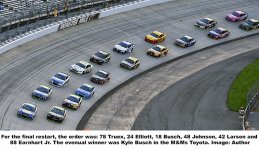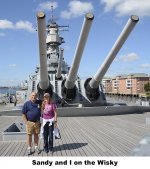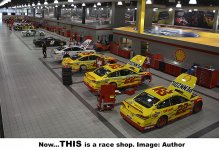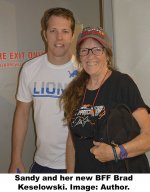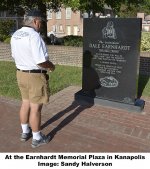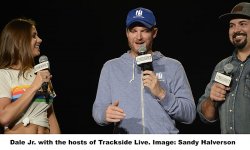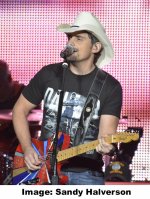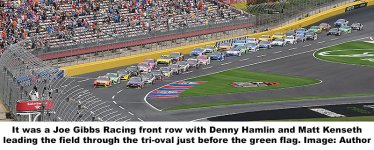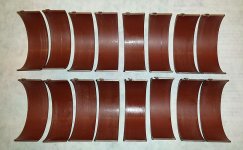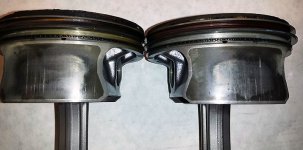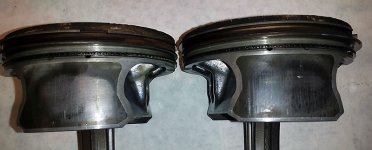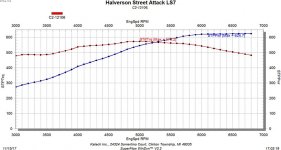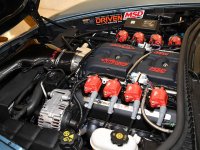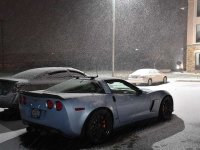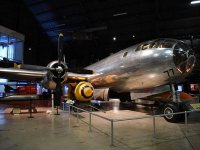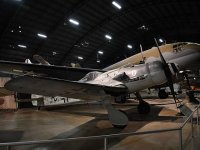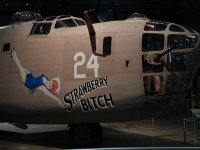- Thread starter
- #321
Hib Halverson
Technical Writer for Internet & Print Media
Blue Bullet Road Trip!!
Last Thursday morning, about 8:00 AM, I rolled out of Goleta on the start of the longest road trip I’ll due to date in the Blue Bullet.
The first part of this “epic journey” is to prerun the route the Southwest Section will take on the 2019 National Corvette Caravan. My shotgun for “PreRun2” is Tony Megowan, the Section Captain for the Southwest Section of the ‘19 Caravan. When the prerun is over, Cap Tony will bail to catch a jet home and I’ll continue on to visit Zip Products in Richmond VA, see friends in D.C. and Doylestown PA and visit the USS New Jersey in Camden NJ. After visiting the battleship, I’ll pickup my Wife, The Fairest Sandra the Red, at Philadelphia International Airport. We’re going to drive the Blue Bullet to the NASCAR Cup races at Dover and Charlotte, visit the Rock and Roll Hall of Fame in Cleveland OH and, finally, drop the car at Katech just outside of Detroit to have them install one of their Street Attack LS7s. From Detroit Metro, Sandy and I will fly home. In early December I’ll fly back to Detroit, get the car from Katech and drive the old Blue Bullet, with it’s (hopefully) 625-hp Katech motor, back home to Goleta. I betcha that’s going to be 6000 miles or so.
Our first overnight on PreRun2 was in Henderson, Nevada and, wouldn’t you know it–the ole BB decided to act-up in Henderson, again. That town southeast of Las Vegas is bad luck for the Blue Bullet. On a road trip in the summer 2015, I had an A/C failure that lasted a day, then it suddenly began working again . On PreRun1 last summer, in record heat, even for southern Nevada, the A/C failed completely. The solution was a 3 AM ruturn home–it was only 97° out then–where I replaced the compressor and condenser. This time, on the drive over to Nevada, there would be brief incidents of the ABS and traction control service lights coming on, the DIC warning of high charge system voltage and MagnaRide and the HVAC going off line. By the time we got to Henderson this was happening often. That night, a look at 2012 service information on ACDelco’s GM Service Information (GMSi) site and a little time on Google had me pretty sure the BB’s generator died, so it was another visit to my pals at Henderson Chevrolet. Fortunately, their parts department had an LS7 alternator in stock and the replacement was a 15-min. job in the parking lot of the Fiesta Henderson Resort where we were staying and where the Caravan will stay in 2019. Problem solved.
This evening we’re in Goodland, Kansas, a small town on I-70, 20 miles east of the state line. We stopped there to recon the town for use as an overnight stop on day Four of the Caravan. The four-day trip to Goodland took us though some of the best highway scenery in the American Southwest. The on-highway eye candy started on the first day when we got off I-15 at Nipton Rd. just west of the Nevada line and saw the best visuals of the eastern Mojave Desert, around Nipton, California and Searchlight, Nevada.
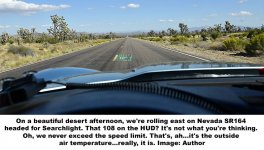
Next day, we drove Northshore Road, which runs northeast in the Lake Mead National Recreation Area along the north end of the Lake. It was another beautiful day for a desert drive. The weather was wonderful–a much welcome contrast with when we were here on PreRun1 back in July when it was never below 115°.
Eventually, we exited the Lake Mead Rec Area and arrived at the Valley of Fire, a Nevada State Park world-renowned for its 40,000 acres of spectacular, right orange Aztec sandstone outcrops nestled in gray and tan limestone. Valley of Fire is just flat breathtaking. On drive we took up the White Domes Road we almost wrecked the Blue Bullet as we gawked speechlessly at the red rocks and tried to take photos while driving. After a return to I-15 and a run north through Mesquite, Nevada and into the extreme northwestern corner of Arizona, we drove through the third scenic wonder of the day, I-15 through the Virgin River Canyon. Twisting though this “mini-Grand Canyon” of sorts, is awesome eye candy. Our second night on the road was in St. George, Utah just north of the Virgin River Canyon. There we met with Doug Rosa, the President of Color Country Corvettes, the club which covers Mesquite NV, St George UT and Cedar City UT. Doug is a member of the Southwest Caravan Organizing Team and his Club will assist with organzing and operating the ‘19 Caravan.
The next day had us continuing our trip north on I-15 to the 15/70 interchange north of Beaver, Utah where we turned east and continued on I-70. I think the stretch of 70 in Utah, between Salina and Green River, is one the most scenic parts of the Interstate Highway system. The 110 miles between the two towns is the longest distance in the Interstate Highway System with no services. It’s, also, the longest section highway in the United States built over a completely new route since the Alaska Highway was constructed during World War II as well as being the longest part of the Interstate System to open at a given time. The construction of the Utah portion of I-70 is one of the engineering marvels of the American Interstate Highway System. The speed limit in those parts is 80-mph. Speed limit? What speed limit? Cruising between 90- and 100-mph and watching my Valentine One, the Blue Bullet made short work of that 110-miles.
This part of I-70 offers an incredible vista to those traveling the highway as it crosses the regions two significant geographical features, the Wasatch Plateau and the San Rafael Swell. You’ll see solid rock canyons, cliffs and mountains, all with exquisite colors. Our run though this part of I-70 was blessed with great weather, cool temperature, deep blue sky and white puffy clouds in the far distance. If you ever get a chance to road-trip your Corvette, hammer-down, over I-70 in Utah, don’t miss it.
After spending the night in Rifle, Colorado and doing another Caravan recon in that town, we started the fourth day of PreRun2 and the scenic vistas of the American West by driving I-70 through Glenwood Canyon. It’s a 12-mile section of I-70 which took 12 years to build. It was completed in 1992 and consists of 40 viaducts and bridges, three tunnels, 15 miles of retaining walls and numerous other structures all of which required 15,000 tons of structural steel, 15,000 tons of rebar and 400,000 cubic yards of concrete. The price was an astonishing $490,000,000–in today’s money that’s well north of three-quarters of a billion bucks–making it by far the most expensive section of highway in the Interstate system. The result is a wondrous, winding, uphill and downhill drive though a narrow canyon with soaring, 2000-ft high rock walls on a road which is, in part, built on viaducts, hanging off canyon walls,
The final experiences of the trip across the Rocky Mountains on I-70 were the climbs up to Vail Pass (10,662-ft) and the West Portal of the Eisenhower-Johnson Tunnel (11,158-ft). We started hitting rain around West Vail along with a lot of Sunday traffic headed to Denver. Interestingly drivers in Colorado are like drivers in California, too many of them are in the left lane in SUVs and crossovers going too slow. That made driving these sections of high-altitude highway a challenge with all the “moving chicanes”. At the top of Vail Pass we began to get snow flurries but the ole Blue Bullet was still one of the fastest on the road, nothing like a 427-inch LS7, even with only half it’s rated power due to altitude, to pass hulking SUVs on the uphill pull to the Eisenhower Tunnel. The new, yellow fog light bulbs I got from Hella helped get the attention of drivers hogging the left lane in front of us. It is a 1.69-mile, twin-bore, four-lane tunnel which is the highest vehicular tunnel in the United States. It took 11 years, the deaths of seven workers and $210,000,000 to build. At the time it was completed in 1979, it was the highest vehicular tunnerl in the World. Driving though the Eisenhower-Johnson and thinking about the effort and resources which went into constructing it boggles the mind.
At the East Portal of the eastbount bore of the Tunnel along we began the 43-mile, 5800-foot descent into Denver through the Silver Plume, Georgetown and Idaho Springs. As we entered the Denver metro area, our 3 1/2 days of incredible eye candy were over. From the western outskirts of Denver in U.S. 6 then I-25 we headed south for the Denver Centenial Airport and the Perfect Landing Restrurant to meet with Captain Dave Effler from the Colorodo Section of the 2019 Caravan and discuss how our two Caravan Sections might join up for the last two days of the event.
After our airport meeting, it was I-70, eastbound, across the great plains of eastern Colorado and western Kansas and it was light rain and ground fog all the way to Goodland. Tomorrow, we’ll make a six hour run to Kansas City. The Blue Bullet will get another wash job as it’s going to rain all day.
In a few days, I'll post some more of my road trip experiences to the Blue Bullet Blog.
Last Thursday morning, about 8:00 AM, I rolled out of Goleta on the start of the longest road trip I’ll due to date in the Blue Bullet.
The first part of this “epic journey” is to prerun the route the Southwest Section will take on the 2019 National Corvette Caravan. My shotgun for “PreRun2” is Tony Megowan, the Section Captain for the Southwest Section of the ‘19 Caravan. When the prerun is over, Cap Tony will bail to catch a jet home and I’ll continue on to visit Zip Products in Richmond VA, see friends in D.C. and Doylestown PA and visit the USS New Jersey in Camden NJ. After visiting the battleship, I’ll pickup my Wife, The Fairest Sandra the Red, at Philadelphia International Airport. We’re going to drive the Blue Bullet to the NASCAR Cup races at Dover and Charlotte, visit the Rock and Roll Hall of Fame in Cleveland OH and, finally, drop the car at Katech just outside of Detroit to have them install one of their Street Attack LS7s. From Detroit Metro, Sandy and I will fly home. In early December I’ll fly back to Detroit, get the car from Katech and drive the old Blue Bullet, with it’s (hopefully) 625-hp Katech motor, back home to Goleta. I betcha that’s going to be 6000 miles or so.
Our first overnight on PreRun2 was in Henderson, Nevada and, wouldn’t you know it–the ole BB decided to act-up in Henderson, again. That town southeast of Las Vegas is bad luck for the Blue Bullet. On a road trip in the summer 2015, I had an A/C failure that lasted a day, then it suddenly began working again . On PreRun1 last summer, in record heat, even for southern Nevada, the A/C failed completely. The solution was a 3 AM ruturn home–it was only 97° out then–where I replaced the compressor and condenser. This time, on the drive over to Nevada, there would be brief incidents of the ABS and traction control service lights coming on, the DIC warning of high charge system voltage and MagnaRide and the HVAC going off line. By the time we got to Henderson this was happening often. That night, a look at 2012 service information on ACDelco’s GM Service Information (GMSi) site and a little time on Google had me pretty sure the BB’s generator died, so it was another visit to my pals at Henderson Chevrolet. Fortunately, their parts department had an LS7 alternator in stock and the replacement was a 15-min. job in the parking lot of the Fiesta Henderson Resort where we were staying and where the Caravan will stay in 2019. Problem solved.
This evening we’re in Goodland, Kansas, a small town on I-70, 20 miles east of the state line. We stopped there to recon the town for use as an overnight stop on day Four of the Caravan. The four-day trip to Goodland took us though some of the best highway scenery in the American Southwest. The on-highway eye candy started on the first day when we got off I-15 at Nipton Rd. just west of the Nevada line and saw the best visuals of the eastern Mojave Desert, around Nipton, California and Searchlight, Nevada.

Next day, we drove Northshore Road, which runs northeast in the Lake Mead National Recreation Area along the north end of the Lake. It was another beautiful day for a desert drive. The weather was wonderful–a much welcome contrast with when we were here on PreRun1 back in July when it was never below 115°.
Eventually, we exited the Lake Mead Rec Area and arrived at the Valley of Fire, a Nevada State Park world-renowned for its 40,000 acres of spectacular, right orange Aztec sandstone outcrops nestled in gray and tan limestone. Valley of Fire is just flat breathtaking. On drive we took up the White Domes Road we almost wrecked the Blue Bullet as we gawked speechlessly at the red rocks and tried to take photos while driving. After a return to I-15 and a run north through Mesquite, Nevada and into the extreme northwestern corner of Arizona, we drove through the third scenic wonder of the day, I-15 through the Virgin River Canyon. Twisting though this “mini-Grand Canyon” of sorts, is awesome eye candy. Our second night on the road was in St. George, Utah just north of the Virgin River Canyon. There we met with Doug Rosa, the President of Color Country Corvettes, the club which covers Mesquite NV, St George UT and Cedar City UT. Doug is a member of the Southwest Caravan Organizing Team and his Club will assist with organzing and operating the ‘19 Caravan.
The next day had us continuing our trip north on I-15 to the 15/70 interchange north of Beaver, Utah where we turned east and continued on I-70. I think the stretch of 70 in Utah, between Salina and Green River, is one the most scenic parts of the Interstate Highway system. The 110 miles between the two towns is the longest distance in the Interstate Highway System with no services. It’s, also, the longest section highway in the United States built over a completely new route since the Alaska Highway was constructed during World War II as well as being the longest part of the Interstate System to open at a given time. The construction of the Utah portion of I-70 is one of the engineering marvels of the American Interstate Highway System. The speed limit in those parts is 80-mph. Speed limit? What speed limit? Cruising between 90- and 100-mph and watching my Valentine One, the Blue Bullet made short work of that 110-miles.
This part of I-70 offers an incredible vista to those traveling the highway as it crosses the regions two significant geographical features, the Wasatch Plateau and the San Rafael Swell. You’ll see solid rock canyons, cliffs and mountains, all with exquisite colors. Our run though this part of I-70 was blessed with great weather, cool temperature, deep blue sky and white puffy clouds in the far distance. If you ever get a chance to road-trip your Corvette, hammer-down, over I-70 in Utah, don’t miss it.
After spending the night in Rifle, Colorado and doing another Caravan recon in that town, we started the fourth day of PreRun2 and the scenic vistas of the American West by driving I-70 through Glenwood Canyon. It’s a 12-mile section of I-70 which took 12 years to build. It was completed in 1992 and consists of 40 viaducts and bridges, three tunnels, 15 miles of retaining walls and numerous other structures all of which required 15,000 tons of structural steel, 15,000 tons of rebar and 400,000 cubic yards of concrete. The price was an astonishing $490,000,000–in today’s money that’s well north of three-quarters of a billion bucks–making it by far the most expensive section of highway in the Interstate system. The result is a wondrous, winding, uphill and downhill drive though a narrow canyon with soaring, 2000-ft high rock walls on a road which is, in part, built on viaducts, hanging off canyon walls,
The final experiences of the trip across the Rocky Mountains on I-70 were the climbs up to Vail Pass (10,662-ft) and the West Portal of the Eisenhower-Johnson Tunnel (11,158-ft). We started hitting rain around West Vail along with a lot of Sunday traffic headed to Denver. Interestingly drivers in Colorado are like drivers in California, too many of them are in the left lane in SUVs and crossovers going too slow. That made driving these sections of high-altitude highway a challenge with all the “moving chicanes”. At the top of Vail Pass we began to get snow flurries but the ole Blue Bullet was still one of the fastest on the road, nothing like a 427-inch LS7, even with only half it’s rated power due to altitude, to pass hulking SUVs on the uphill pull to the Eisenhower Tunnel. The new, yellow fog light bulbs I got from Hella helped get the attention of drivers hogging the left lane in front of us. It is a 1.69-mile, twin-bore, four-lane tunnel which is the highest vehicular tunnel in the United States. It took 11 years, the deaths of seven workers and $210,000,000 to build. At the time it was completed in 1979, it was the highest vehicular tunnerl in the World. Driving though the Eisenhower-Johnson and thinking about the effort and resources which went into constructing it boggles the mind.
At the East Portal of the eastbount bore of the Tunnel along we began the 43-mile, 5800-foot descent into Denver through the Silver Plume, Georgetown and Idaho Springs. As we entered the Denver metro area, our 3 1/2 days of incredible eye candy were over. From the western outskirts of Denver in U.S. 6 then I-25 we headed south for the Denver Centenial Airport and the Perfect Landing Restrurant to meet with Captain Dave Effler from the Colorodo Section of the 2019 Caravan and discuss how our two Caravan Sections might join up for the last two days of the event.
After our airport meeting, it was I-70, eastbound, across the great plains of eastern Colorado and western Kansas and it was light rain and ground fog all the way to Goodland. Tomorrow, we’ll make a six hour run to Kansas City. The Blue Bullet will get another wash job as it’s going to rain all day.
In a few days, I'll post some more of my road trip experiences to the Blue Bullet Blog.
Last edited:


